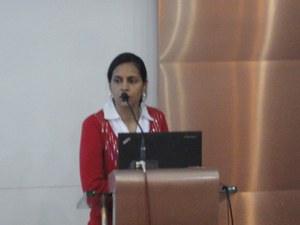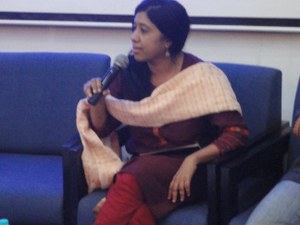Global Accessibility Awareness Day (GAAD 2013) - CIS panel
Interested in understanding the importance of accessibility and how technology can become more accessible by persons with disabilities? Read this post on the Global Accessibility Awareness Day (GAAD)!
Last week, the Centre for Internet and Society (CIS) held a panel on the Global Accessibility Awareness Day which entailed a three hour discussion on how technology can become more accessible by persons with disabilities. GAAD is a community-driven effort with an aim to raise the profile of digital accessibility and people with different disabilities. The target audience of the panel was the design, development, usability and related communities who build, shape, fund and influence technology and its use. This event consisted of presentations by Accessibility professionals in the industry, as well as of hands on demonstrations of how people with disabilities can use technology.
Vivek Gaikwad started his presentation by defining the term “accessibility” as easy access and by pointing out that the World Health Organization considers “disability” an umbrella term covering impairment, activity limitation and participation restriction, which would not only entail the deaf and blind, but even pregnant women. Assistive technology was defined as a device, a technology or a process used by individuals with disabilities to perform functions which might otherwise have been impossible. Gaikwad emphasized that accessibility is an extremely significant issue in terms of legal compliance and would also help create new markets by including people with disabilities.
Section 508 of the U.S. Workforce Rehabilitation Act 1973 was pointed out by Gaikwad, as well as the Web Content Accessibility Guidelines (WCAG) - developed by the Web Accessibility Initiative- which provide an internationally recognized benchmark for accessibility of web content. Gaikwad argued that India should comply with such guidelines and that the best practices to adopt could be the following:
● Provide an appropriate alternative text for all images
● Provide meaningful and hierarchical heading structure
● Provide accessible colours
● Ensure that the application is usable by both the keyboard and the mouse
● Ensure that the focus caret is shown on the active control on the screen
● Ensure that the link purpose is clear
● Specify language of the page
● Understand ECAG 2.0/Section 508 thoroughly
● Educate teams/peers
● Create your own best practices and share them
● Learn how to use a screen reader/other testing tools
● Think in different ways to satisfy a guideline

Lavanya Lakshman started her presentation by introducing the the different types of disabilities and by emphasizing the significance of accessibility. In particular, Lakshman argued that accessibility is important not only because it is the right thing to do, but also because it is the law, it offers benefits for all users, it enhances innovative technology and it creates new market opportunities. Lakshman referred to the various assistive technologies used by persons with disabilities, such as screen readers, to use the computer. It was emphasized that SME testing is important because experts understand how the underlying technologies interact and that end-user testing is also crucial because they are the real experts in their own abilities and their own assistive technology. Accessibility can be tested through automated tools and manual testing and SME testing can be conducted through screening, tool based inspection and evaluation, and code inspection. Laksham highly emphasized that most assistive technologies for people with motor disabilities either work through the keyboard or emulate the functionality of the keyboard, which is why assistive technologies - such as an over sized trackball, an eye-tracker and a head-wand, were recommended.
Srividya Vaidyanathan argued that audio visual media accessibility is needed by everyone and that it should not only be restricted to persons with disabilities. Intelligence picture and sound, accessible players and access services are needed and as there is not much of TV and radio accessibility in India, this field should be further developed. Vaidyanathan also referred to the various types of access services, such as captions (closed and open), sign language and audio description.
Anusuya Das focused her presentation on the print disabled, which are persons who cannot read standard print because of visual impairment, cognitive disabilities (such as dyslexia, autism, ADHD and others), or physical disabilities that limit one´s ability to hold a book. In particular, she argued that braille books include print alternatives and that time and format are critical factors while creating accessible materials. Structure, navigation and simplicity are central concepts of accessible content and it should comply with the Digitial Accessibility Information System (DAISY) standards, which are international standards for accessible content. Das referred to the various advanced accessibility features, such as bookmarking, and emphasized that combined text and audio can increase learning effectiveness by nearly 50%. E-Pub is the mainstream standard, but the United Nations have recommended the DAISY standards. My Studio PC, Obi, Microsoft save as DAISY, Sigtuna DAR 3, Tobi and Dolphin Producer include authoring and production tools.
Das also referred to the various types of DAISY books which may include a full audio and navigation centre, text and no audio or text with audio. Das emphasized upon the need to create accessible word documents, as well as to give alternate text for images and to edit hyperlinks. Principles for regional languages were mentioned, along with the need to convert texts to other formats, such as converting word to HTML. Das also argued that accessible powerpoint files should be created, which would ensure that files have correctly-structured headings among other features. PlexTalk Portable Recorder includes a hardware option for people with disabilities, while Symbian Nokia phones include mobile phone options and other software options are included in the DAISY Book Players.

Rama Chari, the final panelist, referred to the various types of disabilities, as well as to the built needs of people with disabilities. She emphasized that easy navigation in a website is extremely important and that the architecture should be simplified. It was further argued that India should comply with the international standards for information accessibility and that some of the best practices need to be adopted to create new standards. However, such practices vary from state to state in India (e.g. the fire safety standards) which is problematic. Nonetheless, Chari mentioned an organization in Delhi called “Accessibility”, which has very useful guidelines; these include standards for ramps, staircases and washrooms, and it is significant to evaluate the challenges that people with different disabilities face in order to improve such standards.
A discussion on the various tools to increase accessibility followed the presentations of the five panelists, as well as a hands on demonstration by Vivek Gaikwad of how to use more accessible mobile phones. The outcome of the GAAD panel was that in the current Digital Age, persons with disabilities should not be marginalised, but should be included in the social, political and economic structures of the contemporary digitised world. The tools discussed throughout the panel could potentially provide a decisive step in ensuring that persons with disabilities have equal access to technology. As technology today is the gateway to the contemporary world, accessibility is a fundamental human right and persons with disabilities should not be excluded. Through the thorough examination of the various needs of persons with disabilities and the subsequent enactment of adequate laws, standards and guidelines, India should enhance accessibility to technology if it wants to be the democracy it claims to be.


